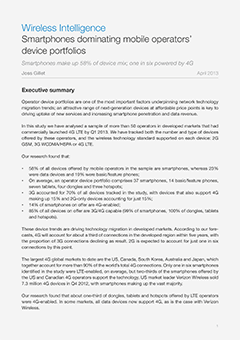Smartphones dominating mobile operators' device portfolios - Smartphones make up 58% of device mix; one in six powered by 4G

This insight is only available to signed in users.
Report details
Smartphones dominating mobile operators' device portfolios - Smartphones make up 58% of device mix; one in six powered by 4G
Operator device portfolios are one of the most important factors underpinning network technology migration trends; an attractive range of next-generation devices at affordable price points is key to driving uptake of new services and increasing smartphone penetration and data revenue.
In this study we have analysed a sample of more than 50 operators in developed markets that had commercially launched 4G LTE by Q1 2013. We have tracked both the number and type of devices offered by these operators, and the wireless technology standard supported on each device: 2G GSM, 3G WCDMA/HSPA or 4G LTE.
Report details
Smartphones dominating mobile operators' device portfolios - Smartphones make up 58% of device mix; one in six powered by 4G
Related research
Digital consumer: five trends to watch in 2026
How will the industry evolve in 2026? This series of reports highlights the key trends to watch and the implications for ecosystem players. This report examines the digital consumer area.
Apple ‘awe-dropping’ event: raising the bar for consumer experience with five areas of innovation
At its recent ‘awe-dropping’ event, Apple unveiled its new line-up of smartphones, earphones and smartwatches, and showcased its innovation in device features.
IFA 2025: an AI-first show with five other defining themes
Like at most other technology shows today, AI was ubiquitous at IFA 2025 – the European consumer electronics show – and the growing application of advanced AI, including generative AI, was clear to see. There were also notable developments across the smart home, wearables, smartphones, home robots and gaming.
Authors
How to access this report
Annual subscription: Subscribe to our research modules for comprehensive access to more than 200 reports per year.
Enquire about subscriptionContact our research team
Get in touch with us to find out more about our research topics and analysis.
Contact our research teamMedia
To cite our research, please see our citation policy in our Terms of Use, or contact our Media team for more information.
Learn moreRelated research
Digital consumer: five trends to watch in 2026
How will the industry evolve in 2026? This series of reports highlights the key trends to watch and the implications for ecosystem players. This report examines the digital consumer area.
Apple ‘awe-dropping’ event: raising the bar for consumer experience with five areas of innovation
At its recent ‘awe-dropping’ event, Apple unveiled its new line-up of smartphones, earphones and smartwatches, and showcased its innovation in device features.
IFA 2025: an AI-first show with five other defining themes
Like at most other technology shows today, AI was ubiquitous at IFA 2025 – the European consumer electronics show – and the growing application of advanced AI, including generative AI, was clear to see. There were also notable developments across the smart home, wearables, smartphones, home robots and gaming.
- 200 reports a year
- 50 million data points
- Over 350 metrics
